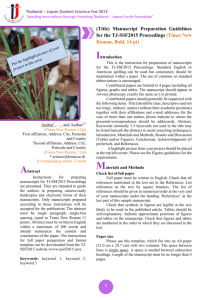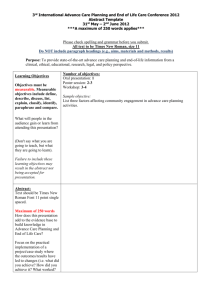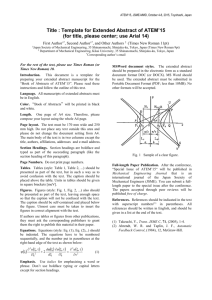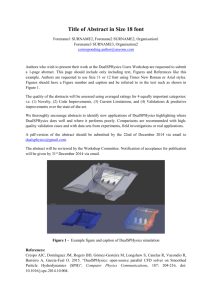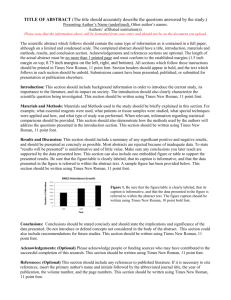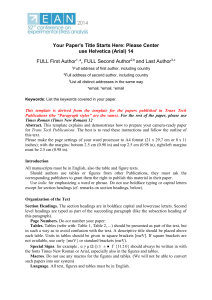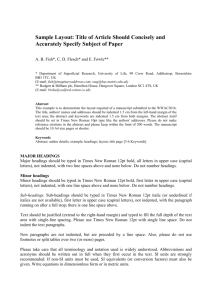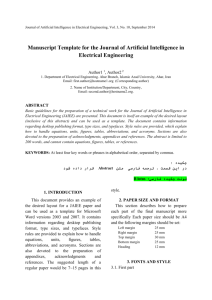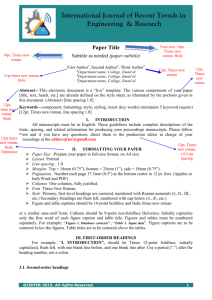Template
advertisement
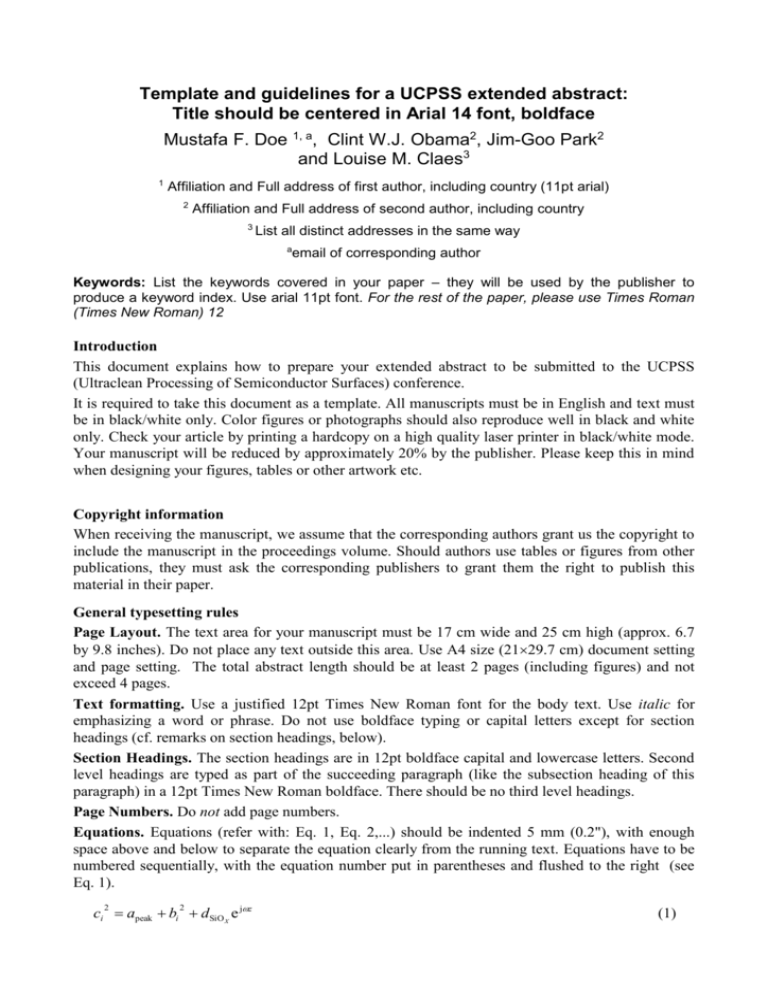
Template and guidelines for a UCPSS extended abstract: Title should be centered in Arial 14 font, boldface Mustafa F. Doe 1, a, Clint W.J. Obama2, Jim-Goo Park2 and Louise M. Claes3 1 Affiliation and Full address of first author, including country (11pt arial) 2 Affiliation and Full address of second author, including country 3 List all distinct addresses in the same way a email of corresponding author Keywords: List the keywords covered in your paper – they will be used by the publisher to produce a keyword index. Use arial 11pt font. For the rest of the paper, please use Times Roman (Times New Roman) 12 Introduction This document explains how to prepare your extended abstract to be submitted to the UCPSS (Ultraclean Processing of Semiconductor Surfaces) conference. It is required to take this document as a template. All manuscripts must be in English and text must be in black/white only. Color figures or photographs should also reproduce well in black and white only. Check your article by printing a hardcopy on a high quality laser printer in black/white mode. Your manuscript will be reduced by approximately 20% by the publisher. Please keep this in mind when designing your figures, tables or other artwork etc. Copyright information When receiving the manuscript, we assume that the corresponding authors grant us the copyright to include the manuscript in the proceedings volume. Should authors use tables or figures from other publications, they must ask the corresponding publishers to grant them the right to publish this material in their paper. General typesetting rules Page Layout. The text area for your manuscript must be 17 cm wide and 25 cm high (approx. 6.7 by 9.8 inches). Do not place any text outside this area. Use A4 size (2129.7 cm) document setting and page setting. The total abstract length should be at least 2 pages (including figures) and not exceed 4 pages. Text formatting. Use a justified 12pt Times New Roman font for the body text. Use italic for emphasizing a word or phrase. Do not use boldface typing or capital letters except for section headings (cf. remarks on section headings, below). Section Headings. The section headings are in 12pt boldface capital and lowercase letters. Second level headings are typed as part of the succeeding paragraph (like the subsection heading of this paragraph) in a 12pt Times New Roman boldface. There should be no third level headings. Page Numbers. Do not add page numbers. Equations. Equations (refer with: Eq. 1, Eq. 2,...) should be indented 5 mm (0.2"), with enough space above and below to separate the equation clearly from the running text. Equations have to be numbered sequentially, with the equation number put in parentheses and flushed to the right (see Eq. 1). ci apeak bi dSiO X e jz 2 2 (1) The (non-italic) roman typeface is to be used for o text-like items: standard mathematical functions (sin, exp,…) and chemical symbols (Au, Ni,…) o values, units (standard units such as Hz, m, kg and imaginary units such as i, j) and indices representing text abbreviations (e.g. Cg, with “g” from “gas”). Single italic letters are used to denote variables: such as symbols for mathematical quantities (x,y,z), symbols of physical quantities (e.g. P, v, T, Cg, with “C” from “Concentration”), mathematical functions (f(x)), and indices representing symbols of physical quantities (e.g. Ga1-xAlxAs). A more detailed overview of the typographic rules regarding equations is given in the American Institute of Physics (AIP) Style Manual [1]. Tables or figures Tables or figures (floating items) can be placed at the most relevant place in the text (i.e. where they are first referred to) or grouped together at the end of the manuscript. In the former case, they should be positioned distinctly from the running text, e.g. by adding empty space above or below the item. Adding captions. Tables and figures should be accompanied by a numbered, self explaining caption. In MS Word, this can be achieved using “insert - caption” from the menu bar and by selecting the appropriate floating item (table or figure). Cross references to tables and figures can be inserted by selecting “insert - cross reference” from the menu bar and by selecting the appropriate floating item from the list. In this way, numbering of the floating items and the corresponding cross references is done automatically. The font for captions is 10pt Times New Roman. Tables. Tables (referred to with: Table I,…) contain one or more header lines, describing the table contents. Units should be given in standard brackets (meV). The table caption (with the table number in roman capital numbers) should be placed above or beside the table. Horizontal lines are used to separate the caption from the table header and from the contents, or to delineate larger table portions. Individual lines of a table should not be separated (see e.g. Table I). Figures. In the case of figures (referred to with: Figure 1,…) the caption, containing the figure number, should be placed below or beside the figure. Please include figures as graphic images in the electronic version. In mathematical plots, no frame should be put around the figure and no gridlines should be used. It is recommended, however, to use x/y mirror axes with appropriate ticks. The font of the labels should be chosen - large enough - such that they are clearly readable. To distinguish different traces or curves from each other one should use an appropriate combination of hashing patterns, marker types or line styles instead of colors or grey scales (see e.g. Figure 1 and Figure 2). For line traces, an appropriate line thickness must be chosen. The background should be white, implying that background color or grey should be removed. Literature References References are cited in the text by square brackets [1]. Two or more references at a time may be put in one set of brackets [2,3]. The references must be numbered in the order in which they are cited in the text and are to be listed at the end of the contribution under a heading References, see our example below. In the references section, the AIP convention [1] is to be used. The references are printed in a 10pt Times New Roman font. Submission - MS Word file The abstract should be saved in a MS Word format and submitted via the official abstract submission module that can be accessed via the conference website www.ucpss.org. Deadline for submission is March 31. Abstracts sent by email will not be accepted. References [1] AIP Style Manual, 4th ed. (The American Institute of Physics, 1997). [2] D.M. Maric, P.F. Meier and S.K. Estreicher: Mater. Sci. Forum 83-87 (1992), p. 119. [3] M.A. Green: High Efficiency Silicon Solar Cells (Trans Tech Publications, Switzerland, 1987). 13 U C P S 2 (at./cm ) 10 10 12 10 11 LDL Forward spin Backward spin Cleaning process Figure 1: Residual contamination after two spin cleaning processes. Table I: Overview of 0(sr) for SiO2 particles using oblique illumination in combination with the wide and narrow detectors of SP1. Detector Wide Narrow Si substrate 0.8 0.3 0.31 0.03 Si3N4 substrate 1.6 0.3 1.8 0.4 pH 10 3.5 3.0 2.5 2.0 1.5 Technique 1 Technique 2 Calculation 14 2 Es (at./cm ) 10 4.0 15 10 10 10 13 12 11 Evaporation Adsorption 10 10 0.1 1 10 100 CEs (ppm) Figure 2: Residual Es contamination as function of Es bulk concentration and pH for two cleaning techniques.
